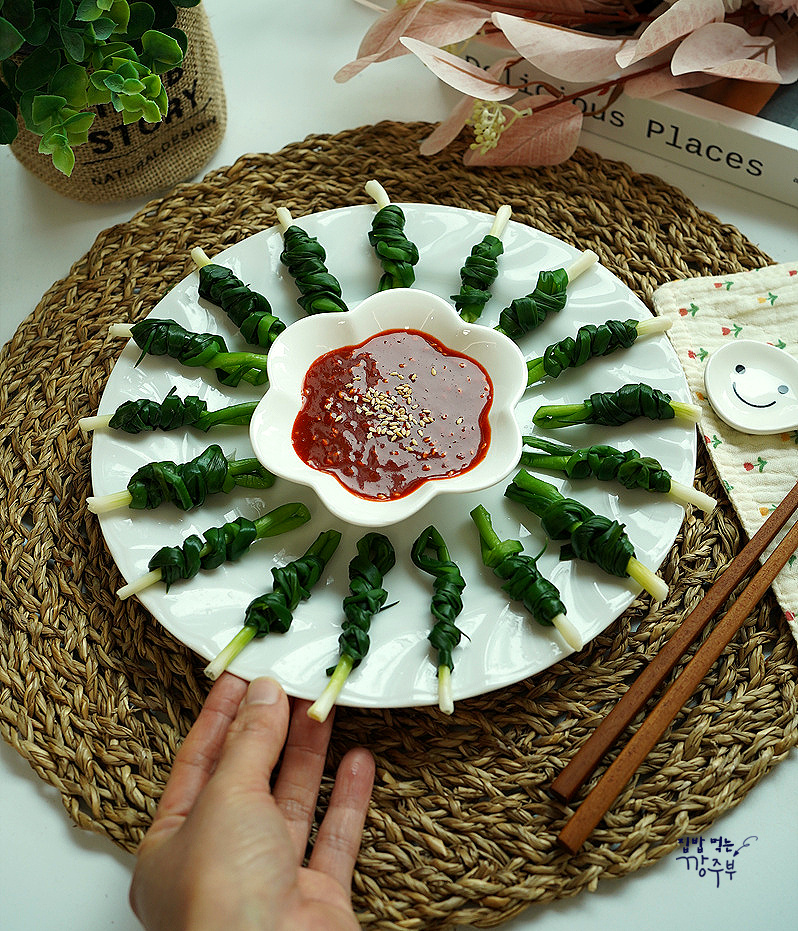Scallion Jeonhoe (Boiled Scallions with Gochujang Sauce)
Easy Homemade Gochujang Sauce with Scallion Jeonhoe Recipe

Recently, I bought a bunch of scallions from the market and had plenty to make various dishes. A few days ago, I made spicy scallion kimchi, and with the leftovers, I made a blanched scallion dish. ‘Scallion Jeonhoe’ might sound fancy, but it’s simply blanched in water and dipped generously in gochujang sauce. It’s commonly made with young scallions (jjokpa), but young green onions (silpa) work just as well and have a similar taste. Blanching removes the sharp, pungent flavor of scallions, bringing out a subtle sweetness that makes you want to keep eating them! It’s perfect as a side dish for drinks or as a delicious accompaniment to rice.
Main Ingredients- 1 bunch young green onions (or scallions)
- 1/2 Tbsp coarse salt (for blanching)
For the Gochujang Sauce- 2 Tbsp gochujang (Korean chili paste)
- 1.5 Tbsp sugar
- 2 Tbsp maesilcheong (plum syrup)
- 3 Tbsp vinegar
- 1/2 Tbsp minced garlic
- 1 Tbsp toasted sesame seeds
- 2 Tbsp gochujang (Korean chili paste)
- 1.5 Tbsp sugar
- 2 Tbsp maesilcheong (plum syrup)
- 3 Tbsp vinegar
- 1/2 Tbsp minced garlic
- 1 Tbsp toasted sesame seeds
Cooking Instructions
Step 1
Scallions (jjokpa) and young green onions (silpa) look similar. Silpa is closer to a young green onion, while jjokpa is a hybrid of onion and green onion, with a slightly different root structure. Because they look so alike, I’ve sometimes bought silpa thinking it was jjokpa. Pay attention to the root difference when purchasing.

Step 2
Gently pull off any yellow or wilted leaves from the base of the scallions, and peel away any dirty outer layers. Trim the root ends neatly with a knife.

Step 3
Here are the neatly trimmed scallions. If you have too many, you can blanch half and save the rest for making savory pancakes (pajeon) on a rainy day – it’s a delicious alternative!

Step 4
Fill a pot with enough water to fully submerge the scallions. Gently swirl the scallions in the water to wash them thoroughly. While washing, pick out any debris or damaged leaves, and rinse both the root and leafy parts carefully.

Step 5
Bring the water to a boil in a pot, then add 1/2 tablespoon of coarse salt. Adding salt to the blanching water helps the scallions retain a vibrant green color, making them look more appealing.

Step 6
Carefully place the washed scallions into the boiling water, starting with the root end.

Step 7
It’s best to blanch the scallions very quickly, for no more than 30 seconds. After adding all the scallions, use tongs to flip them once, then immediately turn off the heat. Over-blanching can make them mushy.

Step 8
Immediately after blanching, remove the scallions from the hot water and place them in a colander. Rinse them under cold running water several times to cool them down completely and stop the cooking process.

Step 9
Gently pat the scallions dry to remove excess water. Then, roll each scallion into a neat spiral, so they are bite-sized and easy to pick up.

Step 10
You can use store-bought gochujang sauce, but homemade is even better! Here’s the perfect ratio for a delicious gochujang sauce that pairs wonderfully with scallion jeonhoe: 2 heaped Tbsp gochujang, 1.5 Tbsp sugar, 2 Tbsp maesilcheong (plum syrup), 3 Tbsp vinegar, 1/2 Tbsp minced garlic, and 1 Tbsp toasted sesame seeds.

Step 11
Combine all the sauce ingredients in a bowl and stir well with a spoon until the sugar is completely dissolved. Taste the sauce and adjust the seasoning, adding more sugar or vinegar if needed, to suit your preference. This easy recipe creates a gochujang sauce that rivals those served at Korean restaurants! My husband tasted it and said it was much better than store-bought, giving it two thumbs up, so definitely give this recipe a try.




